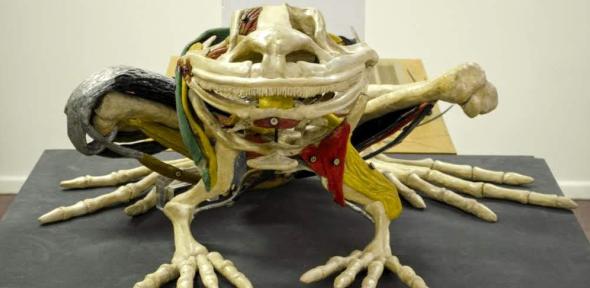
Frogs are often used by scientists as 'model organisms': like mice and fruit flies they are a specific type of animal that is widely studied to provide insight into more general biological processes. Our profile of frogs in the museum both examines and imitates the biological use of 'model organisms' by focusing on frogs as an example of the use of animals in science. Since biological research focuses on and uses living things, our museum represents this history indirectly, preserving the non-living material objects that were used to manipulate, represent and understand these living creatures.
Frogs in the collection
The first question prompted by our profile of 'frogs in the history of science' is both simple and obvious. Why frogs? Why not people, or any other animal in the world? One can answer simply by pointing to the Whipple Museum's collection: we have a relatively high number of objects that are related to frogs. But that prompts another question: why have frogs played such a significant role in the history of science? By surviving in our collection, the Whipple's froggy objects force us to ask: why have scientists so persistently used these strange creatures to ask hugely ambitious questions about life and nature?
Asking our question in this way highlights a key idea in scientific work. In 1929, a physiologist named August Krogh articulated what some now call the 'Krogh Principle.' He wrote "For a large number of problems there will be some animal of choice or a few such animals on which it can be most conveniently studied." Today, we call these 'model organisms.' Krogh's Principle also frames our look into the Whipple Museum's collection: just as scientists will choose one organism to study general phenomena, likewise our exploration of the Whipple Museum's collection selects one organism - the frog - to exemplify how living animals, material objects, and scientific work all interact in fascinating and productive ways.
You may be disappointed to find that we house no live frogs in our collection. The scientific legacy of the frog enters the museum in other ways, through the non-living things that we use to pursue knowledge of living beings. We do have objects that look like or represent frogs, like models, illustrations, and posters. But this page also goes beyond them. Some of our 'froggiest' instruments don't actually resemble frogs - for example the voltaic pile and medico-galvanic machine, which are simply common electrical tools.
Two sub-disciplines in the biological sciences orient this Explore section: zoology and physiology. Those Cambridge departments donated many of the Whipple Museum's froggy objects. These disciplinary affiliations also influence this Explore section's chronological scope: all of our instruments come from the years between 1740 and 1960, when zoology and physiology enjoyed great importance and prestige. The use of frogs in science changed at the beginning of that period, and few of their prior uses leave any material record for many interesting reasons. Our instruments embody the new, modern strategies of investigation into the mechanics of bodily motion and the origins of animal life.
Henry Schmidt
Henry Schmidt, 'Why Frogs?', Explore Whipple Collections, Whipple Museum of the History of Science, University of Cambridge.

